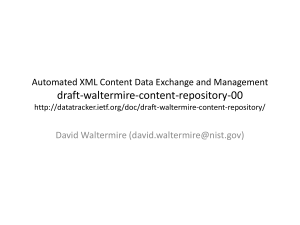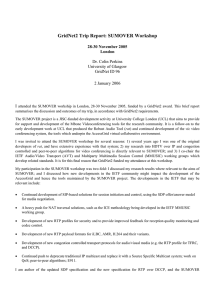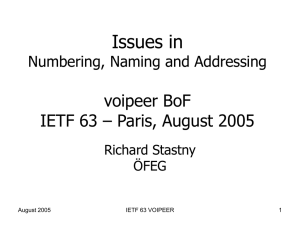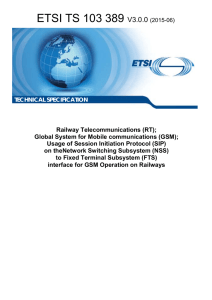Current technical directions in IETF (with emphasis on wireless) James Kempf
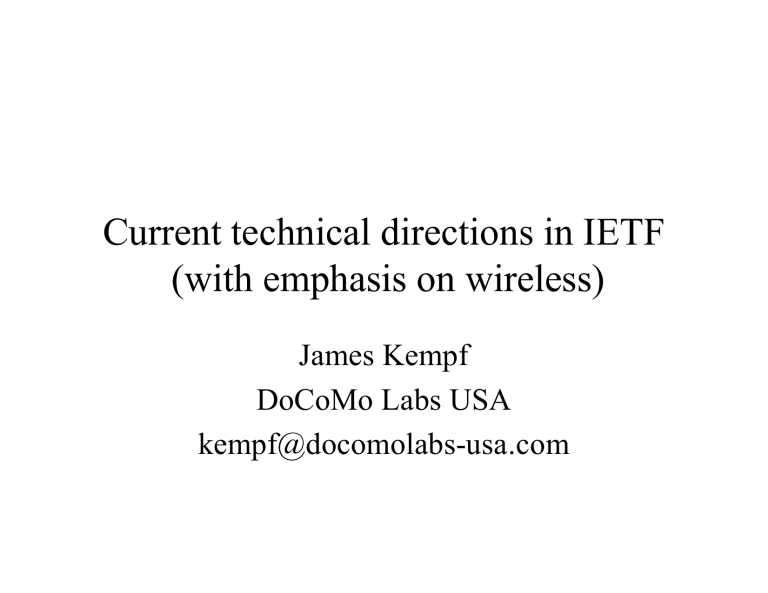
Current technical directions in IETF
(with emphasis on wireless)
James Kempf
DoCoMo Labs USA kempf@docomolabs-usa.com
Background
• IETF has been doing standards for the wired
Internet since late 1980’s.
• In mid 1990’s, convergence of real time media and data traffic started to become technologically possible (high speed optical networks, etc.).
• IETF started working on standards for Internet telephony then.
• IETF moved into wireless as convergence of real time media and data in wireless has become technologically possible (802.11, 3G, etc.).
Outline
Overview of selected Working Groups focused on wireless/telcom themes.
• Applications Area
• Internet Area
• Operations and Management Area
• Security Area
• Transport Area
• Omitted:
– Routing Area – not much wireless related.
• Exception: Ad hoc networking (MANET) but primarily of research interest.
• Telcom related - Continue work on MPLS.
– Sub IP Area – not related to wireless, going away soon.
• Telcom related - Also some work on MPLS, to be moved.
– General Area – primarily organizational.
Applications Area
Geographical Location Privacy
• Requirements for application level geographical location information:
– Authorization, integrity, privacy requirements.
– Transfer between and release to authorized agents.
– Rules for how location information is used and where it goes, specified by owner of information.
• Select an already standardized format for use in representing location information.
• An example API for application-level access to/management of 3G location information.
• Development of specifications that make security and privacy integral to location information in HTTP and
HTML.
Instant Messaging
• Three Working Groups:
– SIMPLE – extend SIP for instant messaging.
– XMPP – standardize XML-based protocol with Jabber technology as base.
– IMPP – interoperability between various IM systems.
• Why three?
– Instant messaging and presence is a natural extension for SIP.
– Jabber has a large deployed base, solid technology, but needs security and internationalization yet.
– Not all devices will have SIP, and not all will have XML (but for instant messaging, you will need one or the other).
– Some requirements and protocol necessary for interoperability between two, and with other proprietary protocols.
• SIMPLE and XMPP are working to satisfy requirements of RFC 2779
(requirements for IM protocols).
Internet Area
Extensible Authentication Protocol
(EAP)
• EAP is an IETF protocol that is heavily used by non-IETF protocols to support multiple authentication methods.
– 802.1x, 3GPP, etc.
• EAP can also be used in IETF authentication
(Diameter).
• Working Group tasks are to clean up and solidify
EAP specification.
• Working Group is not currently chartered to standardize new EAP methods.
Mobile IP
• Working group finished Mobile IPv6 specification.
– Architecturally cleaner than Mobile IPv4.
– Support for secure route optimization.
– Better security support between mobile host and home agent.
• Split Mobile IP into three Working groups:
– MIPv4
• No new work.
• Support operations and deployment only.
– MIPv6
• Simplify, modularize Mobile IPv6 specification.
• Attack a few outstanding issues.
• Address any implementation/deployment issues that might arise.
– MIPSHOP
• Quickly finish work on fast handovers and regional mobility management.
• Publish as Experimental.
Operations and Management
Area
Network Configuration
• New working group, response to June 2002 IAB workshop on network management.
• Today: configuration of network devices is very vendor specific.
• Goal: develop an XML based protocol that:
– Simplifies and standardizes network configuration.
– Makes network configuration tools interoperable.
IPv6 Operations
• IPv6 is no longer experimental, it is being deployed globally for day to day networking needs.
• Deployment is raising issues involving security and interoperability with IPv4.
• Deployment security issues, particularly with IPv4 interoperability mechanisms, require solutions.
• Ongoing, driven by operator concerns.
Security Area
Revisions to IPSec and IKE
• Perception that IPSec and Internet Key Exchange (IKE) are too complicated and lacking support for key technologies.
• IKEv2 addresses concerns with IKE:
– NAT/firewall traversal.
– Support for SCTP.
– Rekeying.
– Support for legacy authentication methods.
• Yet to do (probably in IKEv3):
– Full support for mobility.
• IPSec identity is tied to IP address.
– Flexible policy.
• Policy specification is very firewall like (pass/don’t pass).
Transport Area
Session Initiation Protocol (SIP) and Session
Initiation Protocol Investigation (SIPPING)
• RFC 3261 is latest update of SIP.
– Completed July, 2002.
• Working Group is now dealing with many, many proposals for extensions.
– Too numerous to mention.
• New proposals for SIP extensions are taken to the
SIPPING Working Group where requirements are developed.
– Proposals can come from IETF or from other standards bodies.
– Number of proposals for extensions from 3GPP have been published.
• Requirements are taken to the SIP working group for development of the protocol.
Datagram Congestion Control
Protocol (DCCP)
• Current UDP/RTP mechanism for real time traffic like Voice over IP has no provision for congestion control.
• DCCP provides Transport Level functionality for unreliable data stream with negotiable congestion control.
• Two current congestion control mechanisms:
– TCP-like mechanism.
– TCP Friendly Rate Control (TFRC)
Telephone Number Mapping
(ENUM)
• Updated Basic specification is complete and undergoing deployment.
• Further work required to document any administrative or operational procedures.
• Maintain liaison with other groups (such as
ITU-T).
• Move ENUM to Draft Standard.
Internet Emergency Preparation
(IEPREP)
• Response to 9/11 but extends to all disasters, both natural and man-made.
• Develop requirements for supporting emergency preparedness in the Internet internationally.
• Best Current Practices for operational implementation of services for emergency preparedness using existing Internet protocols.
IP Telephony (IPTEL)
• SIP does not support distribution of call routing information.
• Telephony Routing over IP (TRIP) protocol distributes routing information.
– In particular, to PSTN gateways.
– Similar to BGP.
• New protocol or possible extension to TRIP between TRIP server and signaling (SIP) server.
– Not currently standardized.
– Proprietary solutions.
Conclusion
• IETF experience:
Natural to standardize technology that does not differentiate between real time and data traffic.
• IETF was using this approach in the mid 1990’s for National Network Infrastructure (NNI) and
Global Network Infrastructure (GNI).
• IETF will continue to use that approach now with
Next Generation Networks (NGN).
• IETF views NGN as not fundamentally different from the always morphing Internet.

